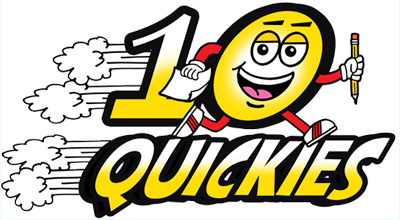Grade Four: Mathematics Content Standards
Number Sense
1.1 Read and write whole numbers in the millions.
1.2 Order and compare whole numbers and decimals to two decimal places.
1.3 Round whole numbers through the millions to the nearest ten, hundred, thousand, ten thousand, or hundred thousand.
1.6 Write tenths and hundredths in decimal and fraction notations and know the fraction and decimal equivalents for halves and fourths
1.8 Use concepts of negative numbers (e.g., on a number line, in counting, in temperature).
1.9 Identify on a number line the relative position of positive fractions, positive mixed numbers, and positive decimals to two decimal
places.
2.2 Round two-place decimals to one decimal or the nearest whole number and judge the reasonableness of the rounded answer.
3.2 Demonstrate an understanding of, and the ability to use, standard algorithms for multiplying a multidigit number by a two-digit number and for dividing a multidigit number by a one-digit number; use relationships between them to simplify computations and to check results.
3.4 Solve problems involving division of multidigit numbers by one-digit numbers.
4.2 Know that numbers such as 2, 3, 5, 7 and 11 do not have any factors except 1 and themselves and that such numbers are called prime
numbers.
Algebra and Functions
1.1 Use letters, boxes, or other symbols to stand for any number in simple expressions or equations.
Measurement and Geometry
1.2 Recognize that rectangles that have the same area can have different perimeters.
1.3 Understand that rectangles that have the same perimeter can have different areas.
1.4 Understand and use formulas to solve problems involving perimeters and areas of rectangles and squares. Use those formulas
to find the areas of more complex figures by dividing the figures into basic shapes.
3.1 Identify lines that are parallel and perpendicular.
3.2 Identify the radius and diameter of a circle.
3.5 Know the definitions of a right angle, an acute angle, and an obtuse angle.
3.7 Know the definitions of different triangles (e.g., equilateral, isosceles, scalene) and identify their attributes.
Statistics, Data Analysis, and Probability
1.2 Identify the mode(s) for sets of categorical data and the mode(s), median, and any apparent outliers for numerical data sets.
|
|
Grade Five: Mathematics Content Standards
Number Sense
1.0 Students compute with very large and very small numbers, positive integers, decimals, and fractions and understand the relationship between decimals, fractions, and percents. They understand the relative magnitudes of numbers:
1.1 Estimate, round, and manipulate very large (e.g., millions) and very small (e.g., thousandths) numbers.
1.2 Interpret percents as a part of a hundred; find decimal and percent equivalents for common fractions and explain why they represent the same value; compute a given percent of a whole number.
1.3 Understand and compute positive integer powers of nonnegative integers; compute examples as repeated multiplication.
1.4 Determine the prime factors of all numbers through 50 and write the numbers as the product of their prime factors by using exponents to show multiples of a factor (e.g., 24 = 2 x 2 x 2 x 3 = 23 x 3).
1.5 Identify and represent on a number line decimals, fractions, mixed numbers, and positive and negative integers.
2.0 Students perform calculations and solve problems involving addition, subtraction, and simple multiplication and division of fractions and decimals:
2.1 Add, subtract, multiply, and divide with decimals; add with negative integers; subtract positive integers from negative integers; and verify the reasonableness of the results.
2.2 Demonstrate proficiency with division, including division with positive decimals and long division with multidigit divisors.
2.3 Solve simple problems, including ones arising in concrete situations, involving the addition and subtraction of fractions and mixed numbers (like and unlike denominators of 20 or less), and express answers in the simplest form.
2.4 Understand the concept of multiplication and division of fractions.
2.5 Compute and perform simple multiplication and division of fractions and apply these procedures to solving problems.
Algebra and Functions
1.0 Students use variables in simple expressions, compute the value of the expression for specific values of the variable, and plot and interpret the results:
1.1 Use information taken from a graph or equation to answer questions about a problem situation.
1.2 Use a letter to represent an unknown number; write and evaluate simple algebraic expressions in one variable by substitution.
1.4 Identify and graph ordered pairs in the four quadrants of the coordinate plane.
1.5 Solve problems involving linear functions with integer values; write the equation; and graph the resulting ordered pairs of integers on a grid.
Measurement and Geometry
1.0 Students understand and compute the volumes and areas of simple objects:
1.1 Derive and use the formula for the area of a triangle and of a parallelogram by comparing it with the formula for the area of a rectangle (i.e., two of the same triangles make a parallelogram with twice the area; a parallelogram is compared with a rectangle of the same area by cutting and pasting a right triangle on the parallelogram).
2.1 Measure, identify, and draw angles, perpendicular and parallel lines, rectangles, and triangles by using appropriate tools (e.g., straightedge, ruler, compass, protractor, drawing software).
2.2 Know that the sum of the angles of any triangle is 180° and the sum of the angles of any quadrilateral is 360° and use this information to solve problems.
Statistics, Data Analysis, and Probability
1.1 Know the concepts of mean, median, and mode; compute and compare simple examples to show that they may differ.
1.3 Use fractions and percentages to compare data sets of different sizes.
1.4 Identify ordered pairs of data from a graph and interpret the meaning of the data in terms of the situation depicted by the graph.
1.5 Know how to write ordered pairs correctly; for example, ( x, y ).
|

